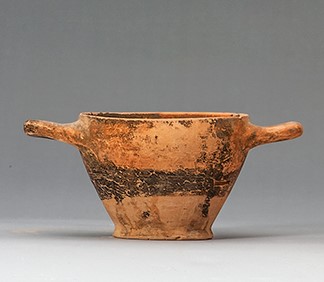
Artefact or object:
Description:
Sicilian Black, Banded and Plain Pottery
Introduction by J.R. Green
The following section contains material from the Woite collection, purchased in 1966 and divided between three Australian universities: New England, Queensland and the ANU. It comprises material apparently from the area of Gela, on the southern coast of Sicily. In addition to the items listed below, the ANU’s share included 1966.06 (miniature Corinthian kotyle), 1966.01, 1966.03, 1966.04, 1966.34, 1966.35 (Attic black glaze), 1966.02, 1966.05, 1966.07-09, 1966.16-33, 1966.36-39 (local pottery), 1966.15 (local lamp), 1966.40-42 (local terracottas).
Gela was an important centre in antiquity. It was founded in 688 BC by colonists from Crete and Rhodes and soon became prosperous; in 582 BC it in its turn founded the city of Akragas/Agrigento further along the coast, reaching what was probably the height of its prosperity in the middle years of the fifth century. One remembers that Aeschylus is reported to have spent the last three years of his life in Gela, before being killed (in 455 BC) when an eagle dropped a tortoise on his head (hoping to smash it on a rock): see conveniently M. Griffith, “Aeschylus, Sicily, and Prometheus”, in: R. Dawe et al. (eds), Dionysiaca: Nine Studies… presented to Sir Denys Page (Cambridge 1978) 105-139, and on the manner of his death W.G. Arnott, “Aeschylus’ Last Eagle?”, in: J. Davidson and A. Pomeroy (eds.), Theatres of Action. Papers for Chris Dearden (Prudentia Suppl., Auckland 2003) 34-42. The people of Gela gave him a lavish burial and his tomb became a site of pilgrimage. On theatrical connections, see further P. Wilson, “Sicilian Choruses”, in: P. Wilson (ed.), The Greek Theatre and Festivals: Documentary Studies (Oxford 2007) 351-377.
More generally, see in the first instance the overview by R. Panvini, Gelas. Storia e archeologia dell'antica Gela (Turin 1996) which contains a useful guide to further reading, together with the volume exploring Athenian pottery found at Gela: R. Panvini (ed.), Ta Attika: veder greco a Gela. Ceramiche attiche figurate dall'antica colonia (Rome 2004). Also C. Raccuia, Gela antica: storia, economia, istituzioni; le origine (Messina 2000); E. Zuppardo and S. Piccolo, Terra mater: sulle sponde del Gela greco (Gela 2005). Note also the recent volume of the Corpus Vasorum Antiquorum Gela (5) covering material from former private collections of locally-found material.
For a good article on locally made pottery such as that here, see C. Ingoglia, “La produzione locale di Gela tra vii e vi sec. a.C.: la ceramica da uno scavo in Via Bonanno (1979)”, Sicilia Antiqua 10, 2013, 199-222.
The vases here may serve to remind us that even at the height of the production of figured wares, the latter formed only one part of total pottery production. This is as much true of later sixth- and fifth-century Athens as of Sicily, even if at this period Sicily was largely dependent on imports for its finer wares. Aside from the art-historical importance of figured vases, our view of Greek pottery is largely coloured by the splendid finds from tombs, particularly those of Etruria. The ordinary Greek household, whether in Athens or Sicily, relied essentially on plain and black pottery for normal use. The accounts from the sale of even Alcibiades’ property show that figured vessels were very much in the minority (see the basic publication by Amyx, Hesperia 27, 1958, 163-310). Although the following items are most likely from tombs, and some were clearly made for the grave, others would have been perfectly suitable for the house and are of types found in domestic contexts.
The dates given below are approximate only, partly because of the state of our knowledge, partly because the material itself does not have the refinement that permits a closer classification. There is a good and useful publication of comparable material by C.L. Lyons, Morgantina Studies V. The Archaic Cemeteries (Princeton 1996).
There has been strong interest in more recent years in the phenomenon of miniature vases in graves and as dedications in sanctuaries. World Archaeology 47.1, 2015, was dedicated to the subject of ‘Miniaturization’. See also G. Ekroth, “Small Pots, Poor People? The use and function of miniature pottery as votive offerings in archaic sanctuaries in the Argolid and the Corinthia”, in: B. Schmaltz and M. Söldner (eds), Griechische Keramik im kulturellen Kontext. Akten des Internationalen Vasen-Symposions in Kiel vom 24.-28.9.2001 (Münster 2003) 35-37, and in the same volume G. Di Stefano, “Vasi greci miniaturistici dalle necropoli classiche della Sicilia. Il caso di Camarina. Giocattoli dalle tombe”, 38-45; S. Barfoed, “The Use of Miniature Pottery in Archaic–Hellenistic Greek Sanctuaries. Considerations on Terminology and Ritual Practice”, Opuscula 11, 2018, 111-126; T. Schattner and G. Zuchtriegel, “Miniaturisierte Weihgaben: Probleme der Interpretation”, in: I. Gerlach and D. Raue (eds), Sanktuar und Ritual. Heilige Plätze im archäologischen Befund (Rahden/Westf. 2013) 259-265. An interesting case from the Athenian Kerameikos is the grave of the Spartans who died fighting on behalf of the Thirty Tyrants in May 403 bc, mentioned by Lysias (II.63), which also contained miniature vessels: J. Stroszeck, “Lakonisch-rotfigurige Keramik aus den Lakedaimoniergräbern am Kerameikos von Athen (403 v. Chr.)”, Archäologischer Anzeiger 2006, 101-120.
Compare the construction of our white-ground lekythos 1968.25.